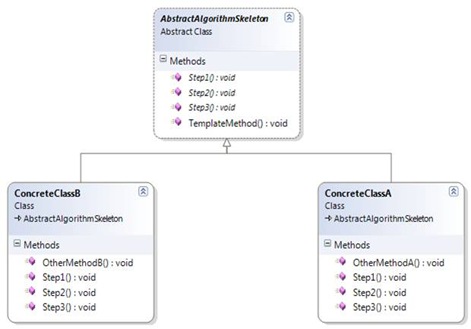Template method design pattern falls under the category of Behavioral Design Pattern. In this pattern, a template method defines a skeleton of an algorithm in terms of abstract operations. The template method can contain one or more steps. But these steps will have to be in abstract form only. That said, we cannot change the order of steps, and most importantly we cannot override the template method itself. Only the steps given in the skeleton of algorithm of template method need to be overridden in concrete classes.
Let’s see how classes can be designed in this template pattern.

Figure: High Level Class Diagram of Template Method Design Pattern
And see the code implementation below:
namespace BehavioralDesignPattern.TemplateMethod
{
public abstract class AbstractAlgorithmSkeleton
{
public void TemplateMethod()
{
Step1();
Step2();
Step3();
}
public abstract void Step1();
public abstract void Step2();
public abstract void Step3();
}
# region "Concrete Implementations of abstract operations defined in Template Method"
public class ConcreteClassA : AbstractAlgorithmSkeleton
{
public override void Step1()
{
Console.WriteLine("ConcreteClassA, Step 1");
}
public override void Step2()
{
Console.WriteLine("ConcreteClassA, Step 2");
}
public override void Step3()
{
Console.WriteLine("ConcreteClassA, Step 3");
}
public void OtherMethodA()
{
}
}
public class ConcreteClassB : AbstractAlgorithmSkeleton
{
public override void Step1()
{
Console.WriteLine("ConcreteClassB, Step 1");
}
public override void Step2()
{
Console.WriteLine("ConcreteClassB, Step 2");
}
public override void Step3()
{
Console.WriteLine("ConcreteClassB, Step 3");
}
public void OtherMethodB()
{
}
}
# endregion "Concrete Classes Implementation"
}
We see the concrete classes are overriding the abstract operations defined by the template method in its algorithm. This way, template method pattern provides an abstract view of algorithm.
So in a practical scenario, this pattern fits only when different types of object instances are required to invoke methods or operations that differ sharply in implementation but the algorithm remains the same. Also, sometimes when we are refactoring multiple classes, we can find template method pattern coming into the picture.
Consuming the Template Method
private void CallTemplateMethod()
{
AbstractAlgorithmSkeleton objTemplate = null;
objTemplate = new ConcreteClassA();
objTemplate.TemplateMethod();
}
An important point to note here is: the way we are calling TemplateMethod() of ConcreteClassA from base class AbstractAlgorithmSkeleton reminds us of “The Hollywood Principle”- “Do not call us, we will call for you”. That is, child class method is being called from base class. This way of method call is also known as Inversion of Control.
That’s it!CodeProject
Filed under: .NET Technologies, Architecture, C#/VB.NET, CodeProject, Design Patterns, Dot Net Tips Tagged: .NET 4.0, .NET3.5, Architecture, Behavioral Design Pattern, C#, Design Patterns, Template Method Design Pattern 





